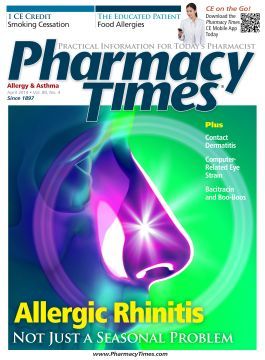Publication
Article
Pharmacy Times
Heparin Allergy: Get "HIT" with the Facts
Author(s):
Heparin-induced thrombocytopenia (HIT) is a well-described adverse drug reaction that can occur with heparin administration and lead to devastating thromboembolic complications.

Heparin-induced thrombocytopenia (HIT) is a well-described adverse drug reaction that can occur with heparin administration and lead to devastating thromboembolic complications.1 HIT is the most frequent drug-induced type of thrombocytopenia and is classified according to the mechanism of thrombocytopenia.
HIT type 1 (HIT-I) is commonly known as heparin-associated thrombocytopenia and is caused by direct platelet aggregation. With HIT-I, platelet counts drop within 48 to 72 hours after exposure to heparin.1,2 Mild and transient thrombocytopenia rarely results in platelet counts below 100,000/mm3, and low counts often return to normal with continued heparin administration.
The less common and more severe HIT type 2 (HIT-II) is caused by an immune-mediated disorder. Antibodies form against heparin-platelet factor 4 (PF4) complex, resulting in pure thrombin generation. Current studies estimate the incidence to be between 0.2% and 5%, depending on the population.3 Furthermore, rates differ among patients depending on the heparin therapy used. In a meta-analysis by Martel et al, the absolute risk for HIT-II with low-molecular-weight heparin (LMWH) and unfractionated heparin (UFH) was 0.2% and 2.6%, respectively.4
HIT-II causes moderately severe thrombocytopenia, with median platelet counts ranging from 50,000/ mm3 to 80,000/mm3.5 In patients with circulating antiheparin-PF4 antibodies, HIT-II may develop within minutes. In some patients, the onset may be delayed by up to 3 weeks and only becomes apparent after heparin has been discontinued. Circulating antibodies take 2 to 3 months to clear; therefore, HIT-II is unlikely unless a patient has had recent heparin exposure.6
With HIT-II, spontaneous bleeding is rare. Besides thrombocytopenia, symptoms include thrombosis, flushing, hypotension, tachycardia, and dyspnea. Most commonly, thrombosis presents as deep venous thrombosis (DVT), pulmonary embolism, venous limb gangrene, and cerebral sinus thrombosis.7 Dermatologic manifestations, such as skin necrosis, present in some patients.8
A pretest probability scoring system called the 4 Ts can be used in patients suspected of having HIT-II. This scoring system assesses the presence and timing of thrombocytopenia, recovery of platelet levels after heparin discontinuation, exclusion of other causes, and occurrence of thrombotic complication.9 According to the American College of Chest Physicians, the clinical diagnosis includes thrombocytopenia that occurs 4 to 10 days after heparin exposure, a decreasing platelet count (to <150,000/mm3 or <50% from baseline), exclusions of other causes of thrombocytopenia, and recovery of platelet levels to 90% of baseline after heparin discontinuation. Laboratory tests for heparin antibodies are available; however, pending lab results should never delay treatment.1
The initial intervention for a patient with suspected HIT-II should be immediate discontinuation of all exposure to heparin. Also, because LMWH cross-reacts with the heparin-induced antibodies, LMWH should be avoided.2 It is important to document heparin allergy within the patient’s record, and a bedside sign should be posted.
Because of a high risk of thrombosis, as long as there is no contraindication (ie, bleeding), patients should receive an alternate form of anticoagulation. It is important that warfarin not be given until thrombocytopenia has resolved. Also, initial use of warfarin alone should be avoided because warfarin therapy may increase the risk of venous limb gangrene in patients with DVT through its rapid lowering of the protein C level. Direct thrombin inhibitors, such as bivalirudin and argatroban, may be used. Also, fondaparinux has a theoretical role in treatment and/or prevention of HIT, because the drug does not appear to interact with platelets or PF4.1,2
With strategies for the early identification of HIT and avoidance of inappropriate heparin therapy, pharmacists can help promote safe and effective anticoagulation. The best way to prevent HIT is the judicious use of UFH or the substitution of LMWH when appropriate. For patients requiring long-term anticoagulation, another strategy involves limiting heparin duration to fewer than 5 days and starting warfarin early.
Even though HIT-II is caused by an immune-mediated reaction to heparin, it is important to remember that it is not a true allergy. PF4 antibodies that cause HIT-II are not long lasting; they typically disappear after 3 months. Consideration of heparin therapy in the future may be appropriate if the PF4 antibody test result is negative.
Dr. Resseguie is an advanced practice anticoagulation pharmacist for the Brigham & Women’s Hospital Anticoagulation Management Service in Boston, Massachusetts.
References:
- Linkins LA, Dans AL, Moores LK, et al. Treatment and prevention of heparin-induced thrombocytopenia: antithrombotic therapy and prevention of thrombosis, 9th ed: American College of Chest Physicians Evidence-Based Clinical Practice Guidelines. Chest. 2012;141:e495S.
- Warkentin TE, Greinacher A, Koster A, et al. Treatment and prevention of heparin-induced thrombocytopenia, 8th ed: American College of Chest Physicians Evidence-Based Clinical Practice Guidelines. Chest. 2008;133:340S.
- Schmitt BP, Adelman B. Heparin-associated thrombocytopenia: a critical review and pooled analysis. Am J Med Sci. 1993;305:208-215.
- Martel N, Lee J, Wells PS. Risk for heparin-induced thrombocytopenia with unfractionated and low-molecular-weight heparin thromboprophylaxis: a meta-analysis. Blood. 2005;106:2710-2715.
- Warkentin TE. Heparin-induced thrombocytopenia: a clinicopathologic syndrome. Thromb Haemost. 1999;82:439-447.
- Warkentin TE, Kelton JG. Temporal aspects of heparin-induced thrombocytopenia. N Engl J Med. 2001;344:1286-1292.
- Lubenow N, Kempf R, Eicher A, et al. Heparin-induced thrombocytopenia: temporal pattern of thrombocytopenia in relation to initial use or reexposure to heparin. Chest. 2002;122:37-42.
- Warkentin TE, Kelton JG. Heparin-induced skin necrosis. Am J Med. 1993;95:662-664.
- Lo GK, Juhl D, Warkentin TE, et al. Evaluation of pretest clinical settings. J Thromb Haemost. 2006;4:75.







